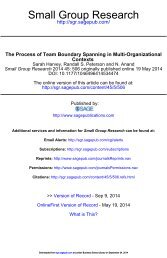A Dynamic Perspective on Diverse Teams: Moving From The Dual Process Model to A Dynamic Coordination-Based Model of Diverse Team Performance - Kannan Srikanth, Sarah Harvey & Randall Peterson
The existing literature on diverse teams suggests that diversity is both helpful to teams in making more information available and encouraging creativity and damaging to teams in reducing cohesion and information sharing. Thus the extant literature suggests that diversity within teams is a double-edged sword that leads to both positive and negative effects simultaneously.
The existing literature on diverse teams suggests that diversity is both helpful to teams in making more information available and encouraging creativity and
damaging to teams in reducing cohesion and information sharing. Thus the
extant literature suggests that diversity within teams is a double-edged sword
that leads to both positive and negative effects simultaneously.
You also want an ePaper? Increase the reach of your titles
YUMPU automatically turns print PDFs into web optimized ePapers that Google loves.
A <str<strong>on</strong>g>Dynamic</str<strong>on</strong>g> <str<strong>on</strong>g>Perspective</str<strong>on</strong>g> <strong>on</strong> <strong>Diverse</strong> <strong><strong>Team</strong>s</strong> † 41<br />
Downloaded by [L<strong>on</strong>d<strong>on</strong> Business School Library], [<strong>Randall</strong> Peters<strong>on</strong>] at 06:11 31 January 2016<br />
Van der Vegt, G. S., Bunders<strong>on</strong>, S., & Kuipers, B. (2010). Why turnover matters in selfmanaging<br />
work teams: Learning, social integrati<strong>on</strong>, and task flexibility. Journal <strong>of</strong><br />
Management, 36, 1168–1191.<br />
Van der Vegt, G. S., Bunders<strong>on</strong>, J. S., & Oosterh<strong>of</strong>, A. (2006). Expertness diversity and<br />
interpers<strong>on</strong>al helping in teams: Why those who need the most help end up getting<br />
the least. Academy <strong>of</strong> Management Journal, 49(5), 877–893.<br />
Van Knippenberg, D., De Dreu, C. K. W., & Homan, A. C. (2004). Work group diversity<br />
and group performance: An integrative model and research agenda. Journal <strong>of</strong><br />
Applied Psychology, 89, 1008–1022.<br />
Van Knippenberg, D. L., & Schippers, M. (2007). Work group diversity. Annual Review<br />
<strong>of</strong> Psychology, 58, 515–541.<br />
Wageman, R. (1995). Interdependence and group effectiveness. Administrative Science<br />
Quarterly, 40(1), 145–180.<br />
Wageman, R. (2003). Virtual processes: Implicati<strong>on</strong>s for coaching the virtual team. In R.<br />
S. Peters<strong>on</strong> & E. A. Mannix (Eds.), Leading and managing people in the dynamic<br />
organizati<strong>on</strong> (pp. 65–86). Mahwah, NJ: Lawrence Erlbaum Associates.<br />
Wageman, R., Fisher, C. M., & Hackman, J. R. (2009). Leading teams when the time is<br />
right: Finding the best moments <strong>to</strong> act. Organizati<strong>on</strong>al <str<strong>on</strong>g>Dynamic</str<strong>on</strong>g>s, 38(3), 192–203.<br />
Wageman, R., Gardner, H., & Mortensen, M. (2012). <strong>The</strong> changing ecology <strong>of</strong> teams:<br />
New directi<strong>on</strong>s for teams research. Journal <strong>of</strong> Organizati<strong>on</strong>al Behavior, 33(3),<br />
301–315.<br />
Wats<strong>on</strong>, W. E., Kumar, K., & Michaelsen, L. K. (1993). Cultural diversity’s impact <strong>on</strong><br />
interacti<strong>on</strong> process and performance: Comparing homogeneous and diverse<br />
task groups. Academy <strong>of</strong> Management Journal, 36, 590–603.<br />
Wiersema, M. F., & Bantel, K. A. (1993). Top management team turnover as an adaptati<strong>on</strong><br />
mechanism: <strong>The</strong> role <strong>of</strong> the envir<strong>on</strong>ment. Strategic Management Journal,<br />
14(7), 485–504.<br />
Williams, K., & O’Reilly, C. (1998). Demography and diversity in organizati<strong>on</strong>s: A<br />
review <strong>of</strong> 40 years <strong>of</strong> research. Research in Organizati<strong>on</strong>al Behavior, 20, 77–140.<br />
de Wit, F. R. C., Greer, L., & Jehn, K. A. (2012). <strong>The</strong> paradox <strong>of</strong> intragroup c<strong>on</strong>flict: A<br />
meta-analysis. Journal <strong>of</strong> Applied Psychology, 97(2), 360–390. doi:10.1037/<br />
a0024844<br />
Zand, D. E. (1972). Trust and managerial problem solving. Administrative Science<br />
Quarterly, 17(2), 229–239.<br />
Zellmer-Bruhn, M. E., Mal<strong>on</strong>ey, M. M., Bhappu, A. D., & Salvador, R. (2008). When and<br />
how do differences matter: An explorati<strong>on</strong> <strong>of</strong> perceived similarity in teams.<br />
Organizati<strong>on</strong>al Behavior and Human Decisi<strong>on</strong> <strong>Process</strong>es, 107, 41–59.
















